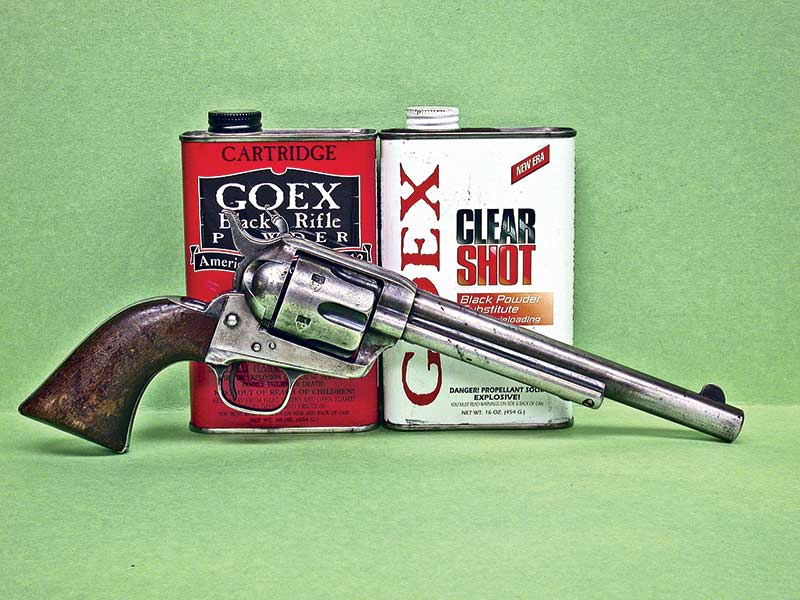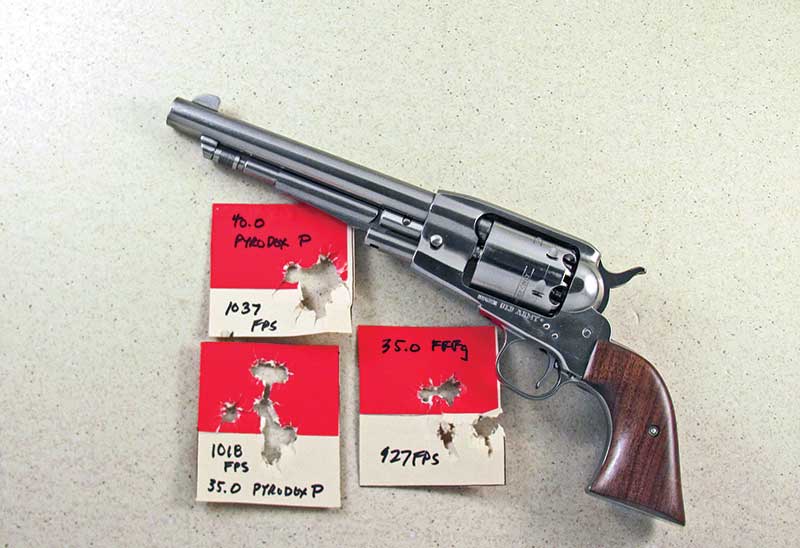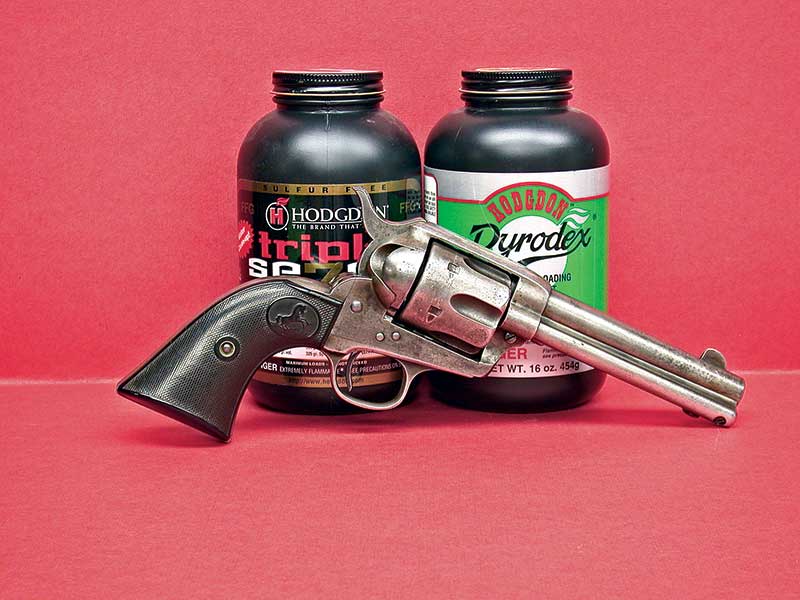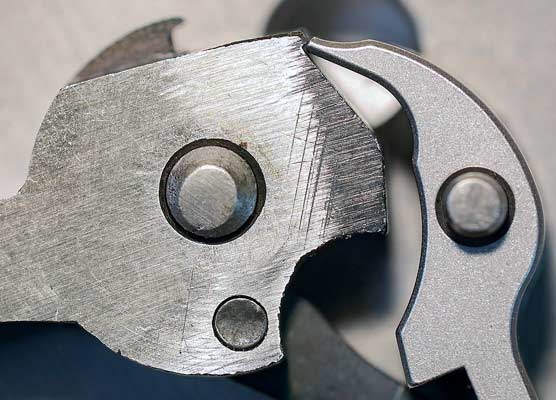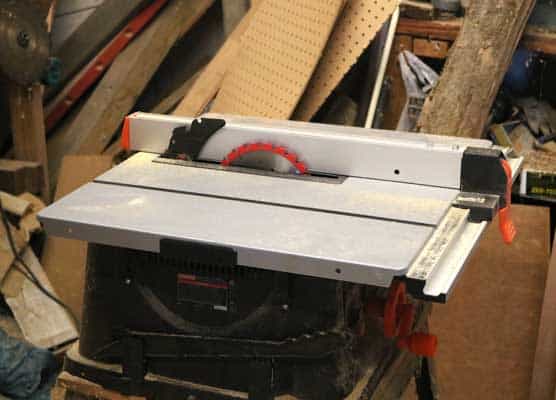Blackpowder 101
Ken Wegman, a Handgunner reader, asked about using black powder and substitutes in modern pistols, comparing their characteristics in velocity, energy, accuracy, cleaning etc. along with a historical review of the actual black powder loads used in handgun calibers. Ken also wondered if there are special requirements/cautions when storing black powder and using modern reloading equipment with black powder? Great questions, Ken!
Historically speaking, black powder was the main propellant for firearms until well into the 20th century, with smokeless powder arriving in the 1880’s. Any Colt Single Action made before 1900 should be considered for black powder use only and all Smith & Wesson .44 and .45 Top-Break sixguns were manufactured for the use of black powder; this, of course, also applies to all percussion revolvers. The Smith & Wesson .44 Russian had a well-deserved reputation for accuracy with the records being set using black powder loads in the 1880’s which stood for decades.
When the Army tested the .45 Colt they had strict requirements for accuracy and Elmer Keith wrote of someone with a 71/2″ Cavalry Model being able to keep someone off of him firing at long range with black powder loads. I tested his theory using a 255-grain bullet loaded over 40.0 grains of black powder, again back in the time when I could really shoot, and I found at 50 yards I could keep them all in the head of a standard silhouette target, 100 yards saw them all go into the body and at 200 yards I could definitely keep the target pinned down until someone showed up who could really shoot. Black powder loads can be just as accurate, or more so, than current smokeless powder loads.
Measuring
All black powder loads, whether using actual black powder or substitutes, are measured by volume not by weight. Using a 40-grain volume measure I came up with the following weights: with black powder Goex FFg weighed 39.9 grains; Goex FFFg, 38.0 grains, and Goex Cartridge, 39.2 grains. Switching to the most popular substitute, Pyrodex P with a volume of 40 grains weighed only 29.6 grains while Pyrodex Select came in at only 25.5 grains.
Different loads will print to different points of impact on the target and only experience with one’s sixgun of choice can answer just what this will be. I did find using a 71/2″ .45 Colt with a 250-grain bullet, 35 grains of Goex Gartridge and Pyrodex P both shoot to the same point of aim with muzzle velocities of 873 fps and 929 respectively.
The original loads for both .45 Colt and .44-40 were 40 grains of black powder. Modern brass, with its solid head, will not hold this much powder, more like 35.0 to 37.0 grains is normal. I have tested the full 40.0-grain load in old balloon head brass and I can definitely tell you there was nothing wimpy about those original loads, with the .45 Colt doing about 900 fps and the .44-40 over 1,000 fps using modern black powder and magnum primers.
Loading/Cleaning
Loading black powder cartridges is not quite the same as loading modern smokeless powder. For best results, bullets chosen should be relatively soft and lubricated with a soft lube specifically designed for black powder use. I’ve found I get the best ignition and cleanest burning results using magnum primers. When shooting black powder loads I usually swab the barrel after each cylinder full.
Over the years I’ve found Windex works as good as anything for this and I simply spray a patch with Windex and run it down the bore. If the cylinder starts to get sluggish in its operation I simply spray Windex at the front and the back without removing the cylinder to clear out some of the fouling. I follow the same procedure when using percussion revolvers. With substitutes, such as Pyrodex, sixguns will normally go through longer strings before they need any attention. With Smith & Wesson replicas or originals fouling is much more pronounced than with a Colt Single Action or replicas.
When I first started shooting black powder there was only one cleaning agent I knew of — hot soapy water. Today there are several excellent black powder cleaning solutions available. If I’m shooting a particular sixgun on a regular basis I thoroughly clean the cylinder and barrel and wipe down all the other parts after shooting. About every third time, I completely dismantle the sixgun and clean all the interior parts. If I’m going to put the sixgun back away after only one shooting session, I perform the same operation. Substitutes are much easier to clean, however they do require cleaning. My friend Ray and I traveled to Texas for a shooting match several years ago and using loads assembled with Hodgdon’s Triple Seven we found we had forgotten to bring along anything for cleaning. A bottle of Listerine worked just fine.
Cautions
When loading black powder cartridges I do not use a normal powder measure but rather the Lyman Black Powder Measure. People still argue about whether or not a spark is possible with the regular measure, which would ignite the black powder. I prefer to err on the side of caution and use only a powder measure designed for black powder use. When using percussion pistols I never load directly from the flask into the cylinder. The reason being there could be a spark lurking in the dark confines ready to give a very dangerous ka-boom.
Instead, the powder is first poured into a hand powder measure, and then only this one load is placed anywhere near the cylinder. I keep several brass flasks with a measuring spout for a particular amount of powder and then this is easily transferred into a hand powder measure. Or I use an adjustable hand powder measure to come up with the proper charge.
Dies
The same press and dies can be used for loading black powder cartridges as for those with smokeless powder. However, RCBS has special Cowboy Dies for .45 Colt, .45 Schofield, .44-40 and .38-40. These are designed to be used with the soft lead bullets normally used in loading black powder cartridges. Black powder substitutes are “probably” safe to use in a regular powder measure, however, since I already have a black powder measure I use it for substitutes too.
Black powder is classified as an explosive and must be handled as such. Always keep it in the original container, always keep the lid on when not actually transferring powder, and especially stay away from any type of spark. Black powder should be stored in its original container and also away from heat and any possibility of a spark. The back room off my garage is always cool and dry and this is where my powder is stored. Check with any local regulations through the fire department to make sure safety is being observed. I also do not like to have a large amount of black powder on hand, so when sample powders become more than I need for normal use I donate it to the local black powder club.
Many shooters will find black powder is not available in their area. We are fortunate to have a black powder club locally and they maintain a black powder storage facility at the shooting range well away from any activity. They sell black powder to members so I can get what I need at any time. At one time we had a local gun shop which also specialized in black powder and black powder accessories, however they are now gone and the large franchise shops only carry Pyrodex. The reason being black powder substitutes are not classified as an explosive and do not require the special handling reserved for black powder. Recently, ATF talked of classifying all powders as explosives, however, thankfully they did back off from that regulation; at least so far.
Accuracy
I earlier mentioned the accuracy of black powder loads. Ruger has dropped their Old Army percussion sixgun, however these show up from time to time in gun shops. I picked up three in the last year. They are exceptionally accurate revolvers when properly loaded and at the last State & Territorial Muzzle Loading match I attended and took part in, I shot my Old Army bullseye style, standing on my hind legs and shooting one-handed as required, and managed to shoot a 95×100 using a round ball and Pyrodex. The .45 Colt, .44-40 and especially the .38-40 and .44 Russian can be especially accurate using black powder or black powder substitutes.

